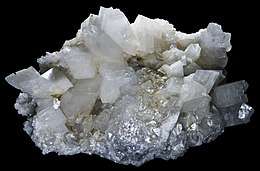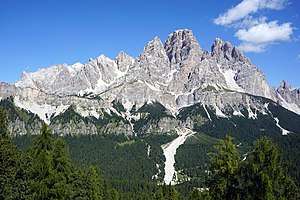Dolomite (mineral)
Dolomite ( /ˈdɒləmaɪt/) is an anhydrous carbonate mineral composed of calcium magnesium carbonate, ideally CaMg(CO3)2. The term is also used for a sedimentary carbonate rock composed mostly of the mineral dolomite. An alternative name sometimes used for the dolomitic rock type is dolostone.
| Dolomite | |
|---|---|
 Dolomite (white) on talc | |
| General | |
| Category | Carbonate minerals |
| Formula (repeating unit) | CaMg(CO3)2 |
| Strunz classification | 5.AB.10 |
| Crystal system | Trigonal |
| Crystal class | Rhombohedral (3) H-M symbol: (3) |
| Space group | R3 |
| Unit cell | a = 4.8012(1), c = 16.002 [Å]; Z = 3 |
| Identification | |
| Color | White, gray to pink, reddish-white, brownish-white,; colourless in transmitted light |
| Crystal habit | Tabular crystals, often with curved faces, also columnar, stalactitic, granular, massive. |
| Twinning | Common as simple contact twins |
| Cleavage | 3 directions of cleavage not at right angles |
| Fracture | Conchoidal |
| Tenacity | Brittle |
| Mohs scale hardness | 3.5 to 4 |
| Luster | Vitreous to pearly |
| Streak | White |
| Specific gravity | 2.84–2.86 |
| Optical properties | Uniaxial (-) |
| Refractive index | nω = 1.679–1.681 nε = 1.500 |
| Birefringence | δ = 0.179–0.181 |
| Solubility | Poorly soluble in dilute HCl |
| Other characteristics | May fluoresce white to pink under UV; triboluminescent. Ksp values vary between 1x10−19 to 1x10−17 |
| References | [1][2][3][4][5] |

History

Most probably the mineral dolomite was first described by Carl Linnaeus in 1768.[6] In 1791, it was described as a rock by the French naturalist and geologist Déodat Gratet de Dolomieu (1750–1801), first in buildings of the old city of Rome, and later as samples collected in the mountains now known as the Dolomite Alps of northern Italy. Nicolas-Théodore de Saussure first named the mineral (after Dolomieu) in March 1792.[7]
Properties
The mineral dolomite crystallizes in the trigonal-rhombohedral system. It forms white, tan, gray, or pink crystals. Dolomite is a double carbonate, having an alternating structural arrangement of calcium and magnesium ions. Unless it is in fine powder form, it does not rapidly dissolve or effervesce (fizz) in cold dilute hydrochloric acid as calcite does.[8] Crystal twinning is common.
Solid solution exists between dolomite, the iron-dominant ankerite and the manganese-dominant kutnohorite.[9] Small amounts of iron in the structure give the crystals a yellow to brown tint. Manganese substitutes in the structure also up to about three percent MnO. A high manganese content gives the crystals a rosy pink color. Lead, zinc, and cobalt also substitute in the structure for magnesium. The mineral dolomite is closely related to huntite Mg3Ca(CO3)4.
Because dolomite can be dissolved by slightly acidic water, areas of dolomite are important as aquifers and contribute to karst terrain formation.[10]
Formation
Modern dolomite formation has been found to occur under anaerobic conditions in supersaturated saline lagoons along the Rio de Janeiro coast of Brazil, namely, Lagoa Vermelha and Brejo do Espinho. It is often thought that dolomite will develop only with the help of sulfate-reducing bacteria (e.g. Desulfovibrio brasiliensis).[11] However, low-temperature dolomite may occur in natural environments rich in organic matter and microbial cell surfaces.[12] This occurs as a result of magnesium complexation by carboxyl groups associated with organic matter.[13] Vast deposits of dolomite are present in the geological record, but the mineral is relatively rare in modern environments. Reproducible, inorganic low-temperature syntheses of dolomite and magnesite were published for the first time in 1999. Those laboratory experiments showed how the initial precipitation of a metastable "precursor" (such as magnesium calcite) will change gradually into more and more of the stable phase (such as dolomite or magnesite) during periodical intervals of dissolution and re-precipitation. The general principle governing the course of this irreversible geochemical reaction has been coined "breaking Ostwald's step rule".[14]
There is some evidence for a biogenic occurrence of dolomite. One example is that of the formation of dolomite in the urinary bladder of a Dalmatian dog, possibly as the result of an illness or infection.[15]
Uses
Dolomite is used as an ornamental stone, a concrete aggregate, and a source of magnesium oxide, as well as in the Pidgeon process for the production of magnesium. It is an important petroleum reservoir rock, and serves as the host rock for large strata-bound Mississippi Valley-Type (MVT) ore deposits of base metals such as lead, zinc, and copper. Where calcite limestone is uncommon or too costly, dolomite is sometimes used in its place as a flux for the smelting of iron and steel. Large quantities of processed dolomite are used in the production of float glass.
In horticulture, dolomite and dolomitic limestone are added to soils and soilless potting mixes as a pH buffer and as a magnesium source.
Dolomite is also used as the substrate in marine (saltwater) aquariums to help buffer changes in the pH of the water.
Calcined dolomite is also used as a catalyst for destruction of tar in the gasification of biomass at high temperature.[16] Particle physics researchers like to build particle detectors under layers of dolomite to enable the detectors to detect the highest possible number of exotic particles. Because dolomite contains relatively minor quantities of radioactive materials, it can insulate against interference from cosmic rays without adding to background radiation levels.[17]
In addition to being an industrial mineral, dolomite is highly valued by collectors and museums when it forms large, transparent crystals. The specimens that appear in the magnesite quarry exploited in Eugui, Esteribar, Navarra (Spain) are considered among the best in the world.[18]
References
- Deer, W. A., R. A. Howie and J. Zussman (1966) An Introduction to the Rock Forming Minerals, Longman, pp. 489–493. ISBN 0-582-44210-9.
- Dolomite Archived 2008-04-09 at the Wayback Machine. Handbook of Mineralogy. (PDF) . Retrieved on 2011-10-10.
- Dolomite Archived 2005-08-27 at the Wayback Machine. Webmineral. Retrieved on 2011-10-10.
- Dolomite Archived 2015-11-18 at the Wayback Machine. Mindat.org. Retrieved on 2011-10-10.
- Krauskopf, Konrad Bates; Bird, Dennis K. (1995). Introduction to geochemistry (3rd ed.). Newyork: McGraw-Hill. ISBN 9780070358201. Archived from the original on 2017-02-26.
- Linnaeus, C. (1768): Systema naturae per regnum tria naturae, secundum classes, ordines, genera, species cum characteribus & differentiis. Tomus III. Laurentii Salvii, Holmiae, 236 p. On p.41 of this very book, Linnaeus stated (in Latin): "Marmor tardum - Marmor paticulis subimpalpabilibus album diaphanum. Hoc simile quartzo durum, distinctum quod cum aqua forti non, nisi post aliquot minuta & fero, effervescens." In translation: "Slow marble - Marble, white and transparent with barely discernable particles. This is as hard as quartz, but it is different in that it does not, unless after a few minutes, effervesce with "aqua forti"".
- Saussure le fils, M. de (1792): Analyse de la dolomie. Journal de Physique, vol.40, pp.161-173.
- "Dolomite Mineral - Uses and Properties". geology.com.
- Klein, Cornelis and Cornelius S. Hurlbut Jr., Manual of Mineralogy, Wiley, 20th ed., p. 339-340 ISBN 0-471-80580-7
- Kaufmann, James. Sinkholes Archived 2013-06-04 at the Wayback Machine. USGS Fact Sheet. Retrieved on 2013-9-10.
- Vasconcelos C.; McKenzie J. A.; Bernasconi S.; Grujic D.; Tien A. J. (1995). "Microbial mediation as a possible mechanism for natural dolomite formation at low temperatures". Nature. 337 (6546): 220–222. Bibcode:1995Natur.377..220V. doi:10.1038/377220a0.
- Snyder, Glen T.; Matsumoto, Ryo; Suzuki, Yohey; Kouduka, Mariko; Kakizaki, Yoshihiro; Zhang, Naizhong; Tomaru, Hitoshi; Sano, Yuji; Takahata, Naoto; Tanaka, Kentaro; Bowden, Stephen A. (2020-02-05). "Evidence in the Japan Sea of microdolomite mineralization within gas hydrate microbiomes". Scientific Reports. 10 (1): 1–13. doi:10.1038/s41598-020-58723-y. ISSN 2045-2322.
- Roberts, J. A.; Kenward, P. A.; Fowle, D. A.; Goldstein, R. H.; Gonzalez, L. A. & Moore, D. S. (1980). "Surface chemistry allows for abiotic precipitation of dolomite at low temperature". Proceedings of the National Academy of Sciences of the United States of America. 110 (36): 14540–5. Bibcode:2013PNAS..11014540R. doi:10.1073/pnas.1305403110. PMC 3767548. PMID 23964124.
- Deelman, J.C. (1999): "Low-temperature nucleation of magnesite and dolomite" Archived 2008-04-09 at the Wayback Machine, Neues Jahrbuch für Mineralogie, Monatshefte, pp. 289–302.
- Mansfield, Charles F. (1980). "A urolith of biogenic dolomite – another clue in the dolomite mystery". Geochimica et Cosmochimica Acta. 44 (6): 829–839. Bibcode:1980GeCoA..44..829M. doi:10.1016/0016-7037(80)90264-1.
- A Review of the Literature on Catalytic Biomass Tar Destruction Archived 2015-02-04 at the Wayback Machine National Renewable Energy Laboratory.
- Short Sharp Science: Particle quest: Hunting for Italian WIMPs underground Archived 2017-05-17 at the Wayback Machine. Newscientist.com (2011-09-05). Retrieved on 2011-10-10.
- Calvo M.; Sevillano, E. (1991). "The Eugui quarries, Navarra, Spain". The Mineralogical Record. 22: 137–142.
External links
| Wikimedia Commons has media related to Dolomite (mineral). |